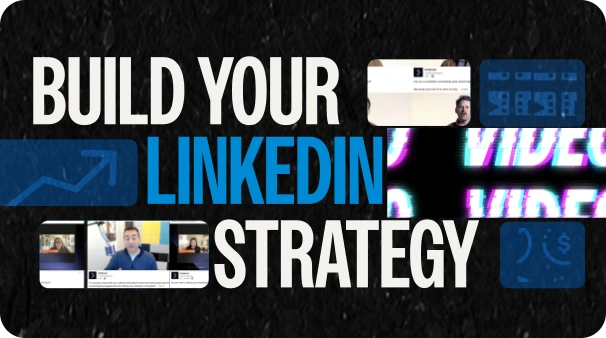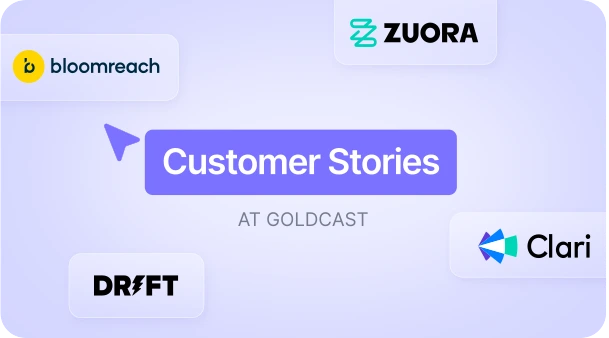How to Record a Podcast Remotely: Your 2025 Guide

Table of Contents
Maximize Your Marketing ROI
Join 10,000 other marketers already getting the best tips on running engaging events that boost pipeline and create raving fans.
There are many upsides to today's distributed work environment, including the ability to work with global talent and a greater sense of work-life balance for employees. If you run a podcast, you're aware that the benefits of remote-first life extend to this endeavor as well — however, you still need to have a solid remote recording strategy in place to succeed!
We know that the majority of B2B decision makers actively listen to podcasts, making this channel a powerful way to reach your target audience. Yet listeners have been spoiled by crystal-clear audio and compelling content, and their standards are high. A poorly recorded remote podcast can quickly turn people off, no matter how insightful your core message is.
In this guide, we'll walk through everything you need to know about recording a high-quality podcast remotely. Whether it's choosing the right software to streamline your podcast production process or understanding the importance of planning your podcast the way you would a virtual event, you'll learn it all.
Read on for key takeaways like these:
- Video conferencing tools are familiar and accessible, but they may not give you podcast-worthy audio quality.
- Dedicated podcast recording software delivers on audio quality, but it can require a steep learning curve.
- Planning your podcast mimics the process of planning a virtual event.
- Repurposing your podcast across channels (and including video as part of your podcast process) can lead to massive returns on your investment.
Let's get started!
Why not just use a video conferencing platform?
Before we get into the nitty-gritty details of remote podcasting, let's clear the air about a common question — can't you just use any old video conference platform to record your podcast?
To be fair, there are lots of reasons to be drawn to this solution. You already use a video platform as part of your workflow, and other people are familiar with them as well, meaning no one has to learn a new software just to come on your podcast.
However, there are some big downsides as well. These platforms, by nature, prioritize video quality and require a stable internet connection during the meeting. Audio quality can suffer as a result. Plus, recording everyone on a single track makes it harder to fix issues or tweak the tracks in post-production.
A dedicated suite like Goldcast Recording Studio solves this problem; with this tool, you don't have to choose between quality and convenience. You can capture both video and audio without being overly reliant on internet stability, and you end up with studio-quality recordings without having to learn a completely new tool.
As we talk more about remote podcast production, think through how each option balances those competing priorities of quality and convenience and what it might be like to implement each one in your current process.
Why video is a critical part of your podcast recording
You might still be thinking of podcasts as an audio-only medium, in which case you'll be surprised to learn that YouTube is actually the top podcast platform right now. That's right: People prefer to watch video podcasts these days!
Combining visual elements with audio creates a more engaging experience, and using video (and YouTube) as part of your podcast strategy helps you to reach new audiences. When you listen to a podcast, you feel like you're part of the conversation — but video takes that to the next level by allowing folks to see facial expressions, body language, and more.
We recommend that you include video recordings as a standard part of your podcast process. You can even ask your guests questions that won't make it onto the podcast episode just to get the resulting video clips. For example, if you're interviewing industry thought leaders, you might ask them what AI video editing tool they're experimenting with right now, and then use those video snippets to develop a series on that topic.
The other amazing benefit of using video in your podcasts is that you'll have a ton of content to repurpose … more on that later!
How to record a podcast remotely: 4 options
When it comes to recording a podcast remotely, you have four major options to choose from. Each one has slightly different advantages and disadvantages, depending on your team's technical expertise, budget, and quality requirements.
Option #1: Video conferencing software
We just talked about this option, but let's break it down a little more. Using a familiar platform like Zoom or Microsoft Teams to record your podcast conversation is an accessible point of entry for podcast beginners. You currently use these tools for work, and your guests are likely pretty familiar with the most common brands as well.
Pros
- Good starting point for hosts, co-hosts, and guests
- Low to no learning curve
Cons
- Audio quality can be less than ideal
- Limited podcast editing options, as all parties are typically recorded on a single track
Pricing
Here's pricing for some of the most-used video conferencing software:
- Zoom: Free for 40-minute sessions, paid plans start at $13.33/month
- Google Meet: Free with Google account up to 60 minutes for group calls, paid options for businesses start at $7/month
- Microsoft Teams: Starts at $4/user per month
How to record a podcast with this method
Here's a step-by-step breakdown of how to record podcasts using video conferencing software:
- Log into your platform of choice
- Schedule your call, and send calendar invites with the meeting link
- Prep everyone ahead of the time to use earbuds and find a quiet space to record
- Hit record once everyone is on the call
- Save the recording after the call ends
- Export the call recording to edit in another program
Ultimately, video conferencing software may work if you're launching a podcast but not particularly concerned about audio quality, or if you're just starting out and want to get things off the ground before you invest in a different method.
Option #2: Podcast recording software
Purpose-built podcast remote recording software means you'll never have to worry about the quality of your audio. These tools — including Goldcast Recording Studio — are designed specifically for podcasters looking to record remotely.
Pros
- High-quality audio and video recordings
- Bypass internet quality issues
- Advanced editing abilities in post-production due to participants being recorded on separate tracks
Cons
- May cost more than general video conferencing platforms
- Have slightly more features to learn than Zoom or Google Meet
Pricing
- Goldcast Recording Studio: Contact us for a demo
- Zencastr: Starts at $18/month
- Riverside.fm: Free up to two hours a month, paid plans start at $15/month
How to record a podcast with this method
Goldcast Recording Studio offers a complete end-to-end solution for podcast creation, repurposing, and distribution. It's custom-built for B2B podcasters looking to maximize the return on their podcasts, customer interviews, thought leadership content, and more.
Here's how you'd record a podcast with our platform:
- Invite participants via an email containing auto-calendar holds
- Once everyone is on the session, start recording! Local HD recordings will be captured on each person's individual device.
- Afterward, use text-based editing to remove filler words, phrases, and mistakes
- Add custom branding elements like speaker name cards and backgrounds
- When you're ready to distribute, export for further editing or publish it directly from Goldcast!
PS: Another benefit of using Goldcast for podcast production is that you're also able to take advantage of Content Lab, our AI-powered video repurposing suite. Because you'll be recording your podcasts with the added video component, it opens up a whole new world of repurposing possibilities to get your podcast content out there!
Option #3: “Double-ender” DIY setup
If you're already familiar with podcasting, you probably know the double-ender recording method, which requires each individual on the call to record their own high-quality audio locally. In the post-production process, the podcast editor then synchronizes the two tracks. Many dedicated podcast recording platforms do this automatically, but you can also set it up with your guests.
Pros
- High-quality audio and video
- Professional-level results
Cons
- Technically demanding on host and guests
- Requires a high level of individual technical awareness
- Significant post-production work to sync recordings
Pricing
- Varies; a common way to achieve this is to use Audacity — which is free — to record the call while you're using a platform like Zoom for the call (free for 40-minute recording sessions, paid plans start at $13.33/month)
How to record a podcast with this method
Here's how to record a podcast using the double-ender playbook:
- Everyone joins a video call on a platform like Zoom or Google Meet
- Each participant is responsible for recording their own audio locally using software like Audacity
- Everyone counts down together at the start before recording starts; some people do a physical "clap" to indicate when it's time to start recording
- After the call, each person sends their audio file to the editor
- The editor synchronizes all recordings and adds music, effects, and other touches to the final file
We think this approach is best for audio professionals with editing and podcast production expertise; you also want to be sure that all of your guests have a pretty good grasp on technology since your final recording can fail if just one person forgets to record.
Option #4: Recording with your smartphone
Finally, you can use the tool you have in your pocket right now! Smartphones have phone recording apps that allow you to capture remote conversations, and most (if not all) of us have a smart device accessible throughout the day.
Pros
- No extra setup or onboarding required
- Phone connections can be more stable than internet/wi-fi
Cons
- Marked decrease in audio quality compared to other methods
- Hard to capture quality video
- Editing options are more limited
Pricing
- Whatever your phone plan costs!
How to record a podcast with this method
Here's how to record audio with your iPhone:
- Call your guest at the agreed-upon time
- Push the appropriate "Record Call" button; this will announce to the guest that they're being recorded
- Conduct the interview
- Push the button to end the recording
- Use the recording file for editing
Recording with your phone is probably best if you have to capture an on-the-go conversation and you don't have another option readily available. You could also save this option as a backup in case another method isn't working.
7 tips to record a podcast remotely without sacrificing quality
Now that we know some of the available podcast recording methods, let's talk about general ways you can ensure that your recordings sound professional.
1. Thoroughly prepare your guests
When remote interviews or discussions with others are part of your podcast, the success of your program hinges heavily on how prepared guests are. Be sure to invest the time up front to brief people on what to expect: Will the guest be recorded on video? How long will the conversation last? What questions will be asked?
To save time and boost efficiency, create a pre-recording checklist that covers the questions above, as well as any relevant technical and equipment requirements — for example, if you prefer remote guests use headphones instead of their computer speakers, let them know so they can plan ahead.
You can also do a dry run before the podcast session, if that's something that will help your guest feel more comfortable. Outside of giving your guest a chance to familiarize themselves with the content and what's expected, you can also use the practice run to check timing and flow of the conversation and make any necessary changes.
2. Invest in quality equipment
You can't control what equipment your guests use, but you can make some investments on your side of the screen to be sure that the audio quality is clear and polished.
There's no need to break the bank here, and if you don't have a big budget for podcast equipment, that's okay! Start off with what you have and try making small upgrades as you continue, noting how those changes affect audio quality.
At a bare minimum, you need a mic and headphones. Here are two of our favorite options:
- USB podcast microphone: These are a pretty standard choice because you can just plug USB microphones directly into your computer. Check out the Audio Technica ATR2100X for under $50!
- Headphones: If you've got Apple headphones on deck, Airpods and Earpods are a solid option.
As your podcast grows, you might upgrade to professional-level gear and start to build out your own recording studio to guarantee professional podcast audio quality. When you're just starting out, however, your time is better spent learning how to make small tweaks to get the most out of basic equipment.
3. Create the right recording environment
Many advanced podcasters have invested great time and resources into creating their own recording studios with perfect lighting and sound quality. Even if you're not there yet, there are steps you can take to positively impact audio quality.
The first step is to choose an area with minimal external noise and echo. That means a smaller room with a couch in it, located more centrally in your home, will be a better choice than a larger, empty room that gets a lot of outside street noise.
If you only have one space as an option and it's not the most ideal, look into hacks you can use to get rid of echos and improve sound quality. Installing acoustic panels is an option, and we've seen people hang blankets in the space to absorb some of the sound. We've even known a few folks to record in their closets to be sure they're insulated from external noise!
When it's time to record, look around for any potential sound disruptors. Loud fans, noisy appliances, cell phone calls — turn everything off if possible or move it out of your recording space. As many of us are working from home, be sure you also tell everyone you live with that you'll be on a call so that you don't get any unexpected interruptions.
4. Plan podcasts like a virtual event
Remote podcast recordings are very similar to virtual events, so approach them with the same level of planning. You'll want a detailed pre-recording timeline, clear communication protocols to use with guests, and backup plans in case you run into any technical issues.
Some tips:
- Schedule recording and publishing dates on the calendar and invite anyone who will be involved.
- Add all editing and post-production tasks with deadlines to your calendar system.
- Send calendar invites with meeting links to your guests.
- Create a system for guest outreach so that you have a constant pipeline of podcast episodes to record. If you're able to record multiple episodes in a "batch," this can be helpful if a guest falls through and you need to publish another episode unexpectedly.
Planning in this way helps you to be consistent in your publishing frequency, which is one of the most important parts of running a podcast. If you say you'll be releasing a new episode every two weeks, then stick to it so you don't lose credibility with your audience. Planning makes that happen!
5. Prioritize content quality
From a technical aspect, sound quality is probably the most important thing to focus on. However, don't lose sight of the substance of your podcast — you can have the crispest audio out there and lose listeners if your content isn't engaging and valuable.
First, be sure that your topics are interesting to audience members. You may already know that there's interest in your subject matter based on conversations you've had with customers or prospects, or you might validate your topic through surveys, polls, and social media posts.
Once you know what your podcast is about, think about interesting thought leaders you can invite on to discuss that topic. Ask your audience what they want to know, and then ask your guests those questions. Create momentum on social media and other channels by teasing your content or sharing sneak peeks of an episode to get people talking.
One tip: Ask your guests who they think you should talk to next. This can lead to new connections and interesting conversations with SMEs who you weren't aware of before.
6. Don't treat editing like an afterthought
Ideally, the podcast recording tool you choose produces high-quality audio files, but you still need to edit them. When you're mapping out the time investment required for each episode, build editing in from the start so that it doesn't become an afterthought.
Typically, you (or the podcast editor) would remove any blunders that happened during recording — it can be helpful for the person speaking to actually flag that segment and say, "Let's remove this," or, "Let me start over" so the editor can easily pick up on it. You can also get rid of filler words, long pauses, and add any music or transitional sounds you like.
You can fix a lot during editing — for example, background noise or differences in audio levels between speakers — but there are some things that can't be fixed, which goes back to the importance of #3 and creating the right recording environment. If your issues stem from recording in a room full of echoes, you likely can't fix that with an editing tool, so get ahead of those issues before they show up on your recording!
7. Focus on distribution and promotion — and repurpose!
Once you've got your podcast episode edited and ready to go, it's time to share it with the world!
Develop a multi-channel distribution strategy that includes the major podcast platforms like Apple Podcasts, YouTube, and Spotify. You should also promote podcast episodes on your website, social media channels, and in email newsletters.
Don't assume people know about your podcast and definitely don't assume that if you've told them once, you don't have to tell them again!
To take things to the next level, repurpose your podcast content to easily come up with other content assets you can use to power your content strategy. If you've recorded the video footage of your podcast episode (and hopefully you have!), you can upload that to a tool like Goldcast Content Lab and, within seconds, generate social media posts with video snippets, blogs, and more.
Record, edit, publish, share and repurpose: Goldcast Recording Studio does it all
To create a successful podcast, you have to manage multiple moving parts. You need a platform that allows you to record high-quality video and audio files, editing software, as well as a distribution and promotion plan, and — ideally — a tool to repurpose those video recordings into other valuable content.
Goldcast does all of these things! It's a tool custom-built for B2B marketers, and our new Recording Studio is created to allow podcasters to fit their medium within a larger B2B marketing strategy.
There are infinite benefits to keeping all of your event, video, and podcast production tasks in the same platform. First, you mitigate the risk involved when you have multiple people jumping back and forth between different platforms — that can easily lead to accidental errors and mistakes.
Beyond that, you streamline workflows and boost efficiency for yourself and your team. You're able to maximize the impact of your content because you have all of the tools you need to record your podcast, edit the files, publish and distribute them, and repurpose the files afterward — all in one place!
Here are just a few of the features Goldcast Recording Studio provides:
- Automatically send podcast guests calendar invites and meeting links
- Capture local recordings of speakers from individual devices, ensuring the highest quality results
- In-suite transcription, captions, subtitles, and more
- User-friendly DIY editing options to tighten up your recording before publishing
- Publish edited recordings directly to your video hub or add them to pre-recorded content
- Repurpose video and audio files into multimodal content like blogs, audiograms, social media posts, and more
When you keep your entire podcast workflow in one platform, you'll produce more consistent content across all channels, save significant time and resources, and get the most value possible out of every single video recording.
Best of all? You can get a free demo of Goldcast Recording Studio now or sign up for Content Lab for free and experience its repurposing wizardly for yourself!
Stay In Touch
Platform
Resources
Company
Community
© 2025 Copyright Goldcast, Inc. All rights reserved.



 Upcoming Events
Upcoming Events Event Series
Event Series On-Demand Events
On-Demand Events

